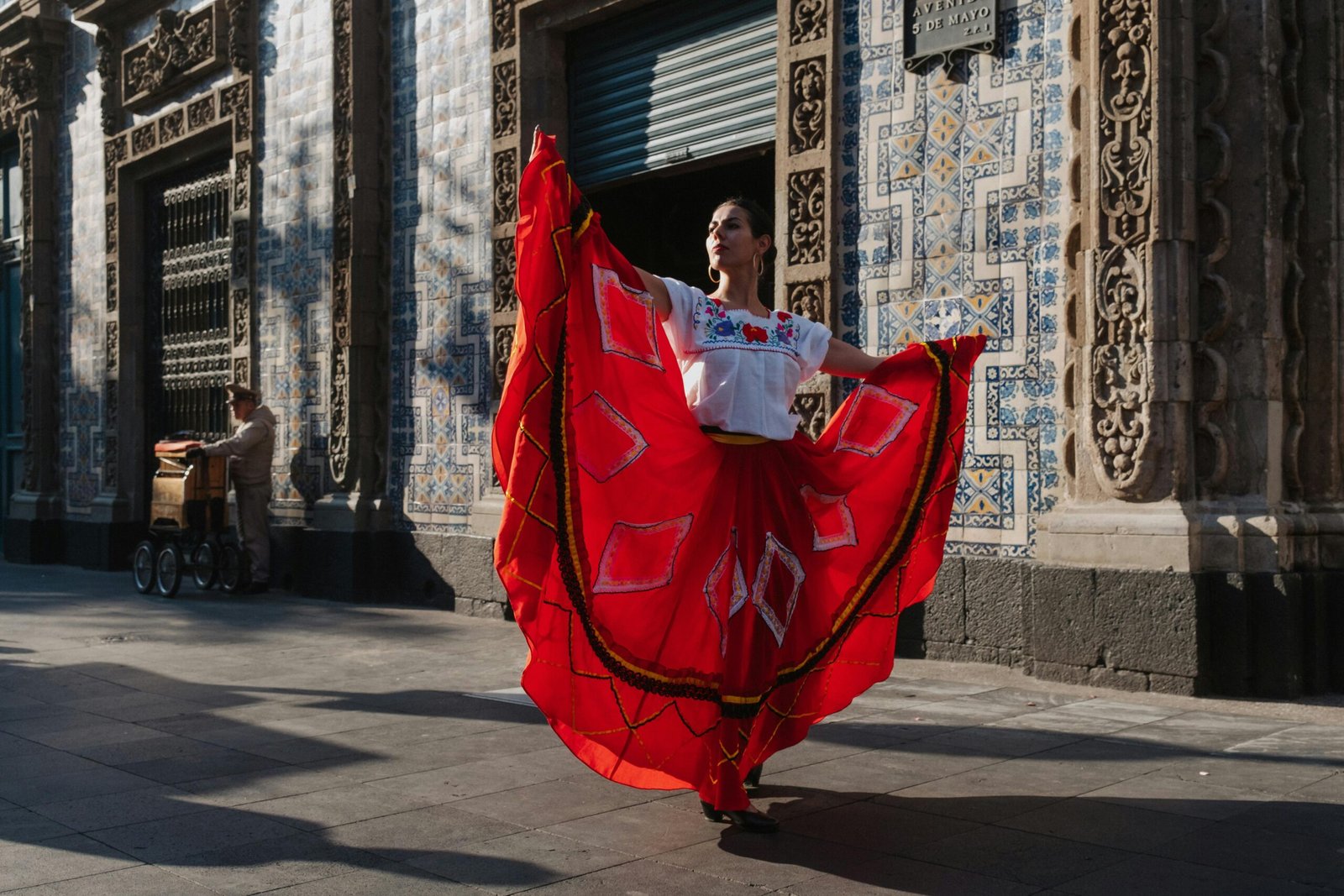Traditional Cuban Clothing
Explore the vibrant world of Traditional Cuban Clothing, where history and style converge. Discover the iconic Guayabera, colorful Bata Cubana, and other traditional garments that define Cuba’s rich cultural heritage and influence on global fashion.”
Introduction
Cuban culture buzzes, alive and colorful. At its heart? The clothes. They’re not just fabric and thread. Oh, no. Each piece tells a tale, whispers of past and present, mingling. Think about it. The vibrant hues? They shout of Cuba’s zest, its relentless sun. And those designs, simple yet smart, echo the island’s pulse, its dance with time and outsiders.
Dig deeper. Every stitch holds history. These garments, they’ve seen eras glide by. From indigenous roots, Spanish flair, to African beats, they’ve soaked it all up. It’s a fashion feast, really. And the symbols! They’re not random. They speak of identity, of pride, in a language bold and silent.
Now, Cuban fashion isn’t stuck in time. It evolves, breathes new life into old fibers. It’s a mix, a match, a dialogue between yesterday’s threads and today’s streets. What a sight! This fusion, it’s the real Cuba. Vibrant, fluid, ever-changing. Yet, forever steeped in the richness of its woven past.
Historical Background
Cuban traditional clothing is like a vivid tapestry, rich with history. Before the Europeans came, the Taino people, native to the island, wore only simple garments, suited to the hot climate. Then the Spanish arrived, mixing their European styles with the local ones. But that’s not the whole story. Africans, forced into slavery, brought their own dress customs, adding another layer to the cultural mix.
Over time, this blend transformed, shaped by Cuba’s shifting politics, economy, and social currents. Today, what we see in Cuban fashion is a unique style, born from this intricate historical journey. It’s a living expression of the island’s past and present, showcasing a special fusion that has matured through centuries of change and adaptation.
Iconic Cuban Garments
Central to Cuban traditional fashion are the Guayabera and Bata Cubana, garments steeped in cultural heritage and practicality.
Guayabera: The Cultural Emblem The Guayabera shirt, known for its four front pockets, pleated lines, and often short sleeves, is a symbol of Cuban identity. Originating as practical wear for rural workers in Cuba’s heat, it has evolved into a symbol of national pride. Crafted from airy fabrics like linen or cotton, the Guayabera has journeyed from its modest beginnings to a staple in formal and festive attire throughout Latin America and beyond.
Bata Cubana: Dance and Identity The Bata Cubana, a dress bursting with ruffles and vibrant colors, is vital to Cuban dance folklore. It embodies the soul and energy of Cuban music, with its design enabling the lively movements required in dances like the Rumba and Mambo. Reflecting African heritage, the Bata Cubana’s exuberant layers and colors carry deep cultural meanings, making it a powerful expression of identity and tradition.
Women’s Traditional Attire
Traditional Cuban clothing for women includes a variety of styles, from simple daily outfits to fancy costumes for festivals and dances. Their dresses are often decorated with ruffles, lace, and flower designs. This style comes from Spanish influences but has changed to suit Cuba’s warm weather. These clothes are not just pretty; they also express the cultural identity and variety of the different regions in Cuba. The article would go into detail about the importance of these clothes, how they have changed over time, and their role in both Cuban culture and the wider world of fashion. It aims to provide a full and interesting story of traditional Cuban dress.
Men’s Traditional Wear
For Cuban men, their traditional clothing is both practical and stylish. Apart from the well-known Guayabera shirt, men often wear light pants and shirts, usually with straw hats like the Panama or Yarey, which are perfect for staying cool under the Cuban sun. These clothes are made from natural materials and combine comfort with a neat look. The development of men’s traditional clothing in Cuba shows the transition from rural life to city life, reflecting a fashion sense that is deeply connected to its historical roots while also keeping up with modern trends.
Children’s Apparel in Cuban Tradition
Children’s clothing in Cuba often mirrors adult traditional wear, with boys donning miniature Guayaberas and girls dressed in ruffled, vibrant dresses akin to the Bata Cubana. These garments are more than just clothing; they are symbols of cultural pride and heritage. Festivals and family celebrations are particularly special occasions where the richness of Cuban traditional clothing comes to the forefront, with children adorned in the nation’s colors and patterns, embodying the cultural legacy and future.
Accessories and Embellishments
Accessories are pivotal in completing the traditional Cuban look, encompassing a variety of items from headwear to jewelry. The iconic Panama hat, originally from Ecuador but strongly associated with Cuban style, is a common sight, offering both shade and style. Jewelry made from native materials like coral, wood, and seeds adds a distinctive touch, reflecting the island’s natural beauty and artisanal craftsmanship. Embellishments such as embroidery, beading, and lace further enhance the garments, adding layers of texture and cultural narrative.
Fabrics and Textiles
The choice of fabrics in Cuban traditional clothing is heavily influenced by the island’s tropical climate. Linen and cotton predominate, prized for their breathability and comfort in the heat. Silk and organza are used in more formal or celebratory attire, providing a delicate and elegant touch. These materials not only cater to the climatic needs but also reflect the natural resources and economic conditions of the region.
Colors and Motifs
The color palette and patterns in Cuban traditional wear are as dynamic as the island’s culture itself. Bright hues like red, blue, and yellow are staples, symbolizing the vibrancy of Cuban life and landscapes. Floral and geometric patterns often adorn garments, each with its own meaning and origin, drawing from the island’s diverse flora and cultural heritage.
Cuban Fashion in Celebrations
Traditional clothing plays a central role in Cuban festivals and celebrations, each with its distinct attire. Carnival, for instance, sees a riot of colors and patterns, with costumes that blend historical influences and contemporary creativity. Weddings and religious ceremonies also have specific traditional dress codes, with outfits that respect age-old customs while accommodating modern tastes.
Global Influence and Trends
Cuban traditional fashion has transcended its local roots to influence global trends. The Guayabera, for example, has been embraced in various parts of the world as a symbol of relaxed elegance, adapted into different styles and colors. Cuban chic, with its blend of tropical ease and classical lines, continues to inspire designers and fashion enthusiasts, making its mark on international runways and street styles.
Conservation of Heritage
Preserving the heritage of traditional Cuban clothing is a vital endeavor, with various initiatives in place to maintain and celebrate this cultural expression. Museums, cultural centers, and fashion institutes in Cuba and abroad are involved in documenting, studying, and showcasing traditional Cuban garments, ensuring that the legacy of these sartorial traditions continues to thrive.
Conclusion
Traditional Cuban clothing weaves a story rich with history, culture, and artistry, capturing the essence of Cuba’s spirit. Each piece, from the functional Guayabera to the festive Bata Cubana, narrates the island’s saga, mirroring its challenges, achievements, and unceasing energy. As Cuba weaves through the delicate balance of tradition and modernity, its attire stands as a dynamic symbol of its cultural legacy.
Through this journey into traditional Cuban attire, we’ve navigated the island’s historical landscape, partaken in its vibrant festivities, and acknowledged its influence on the global fashion stage. This exploration uncovers the depth and expanse of Cuban style, which is distinctly Cuban in essence yet commands worldwide admiration. It’s a celebration of a tradition that remains alive and evolving, proudly reflecting the enduring spirit of the Cuban people.
FAQs-Traditional Cuban Clothing
What is the historical significance of the Guayabera in Cuban culture? The Guayabera, often referred to as the “Cuban shirt,” holds a significant place in Cuban culture and history. Originally designed for the practical needs of the rural population, its breathable fabric and roomy pockets made it ideal for working in Cuba’s hot climate. Over time, the Guayabera evolved into a symbol of national identity and elegance, bridging the gap between formal and casual wear and becoming a staple in Cuban dress for various social and official events.
How has Cuban traditional clothing evolved over time? Cuban traditional clothing has evolved through a confluence of indigenous, Spanish, African, and Caribbean influences. Initially, indigenous and simple, the arrival of Spanish colonists introduced European fashion, which then mixed with African cultural elements brought by enslaved people. Over the centuries, this fusion has led to a unique sartorial identity, adapting to social changes, economic shifts, and contemporary fashion trends while retaining its traditional roots.
What are the common materials used in Cuban traditional attire? The most common materials used in Cuban traditional attire are linen and cotton, chosen for their lightness and breathability in the tropical climate. Silk, organza, and guayabera fabrics are also used, particularly in formal or ceremonial garments. These materials reflect the island’s natural resources and cultural preferences, blending functionality with aesthetic appeal.
How is traditional Cuban clothing represented in festivals and cultural events? Traditional Cuban clothing is a vibrant element of festivals and cultural events, embodying the nation’s heritage and communal spirit. During events like Carnival or the Fiesta del Fuego, people don vibrant, colorful costumes that reflect historical influences and contemporary fashion. These garments, often adorned with accessories and embellishments, play a crucial role in the festivity’s visual spectacle and cultural expression.
What efforts are being made to preserve traditional Cuban clothing? Efforts to preserve traditional Cuban clothing include educational programs, museum exhibitions, and cultural festivals that celebrate and showcase traditional attire. Artisans and designers are also reviving traditional techniques and styles, integrating them into modern fashion while maintaining the cultural essence. Additionally, initiatives aimed at documenting and researching traditional Cuban fashion help to ensure its continuity and appreciation for future generations.
Read Article: Baby Winter Clothes













